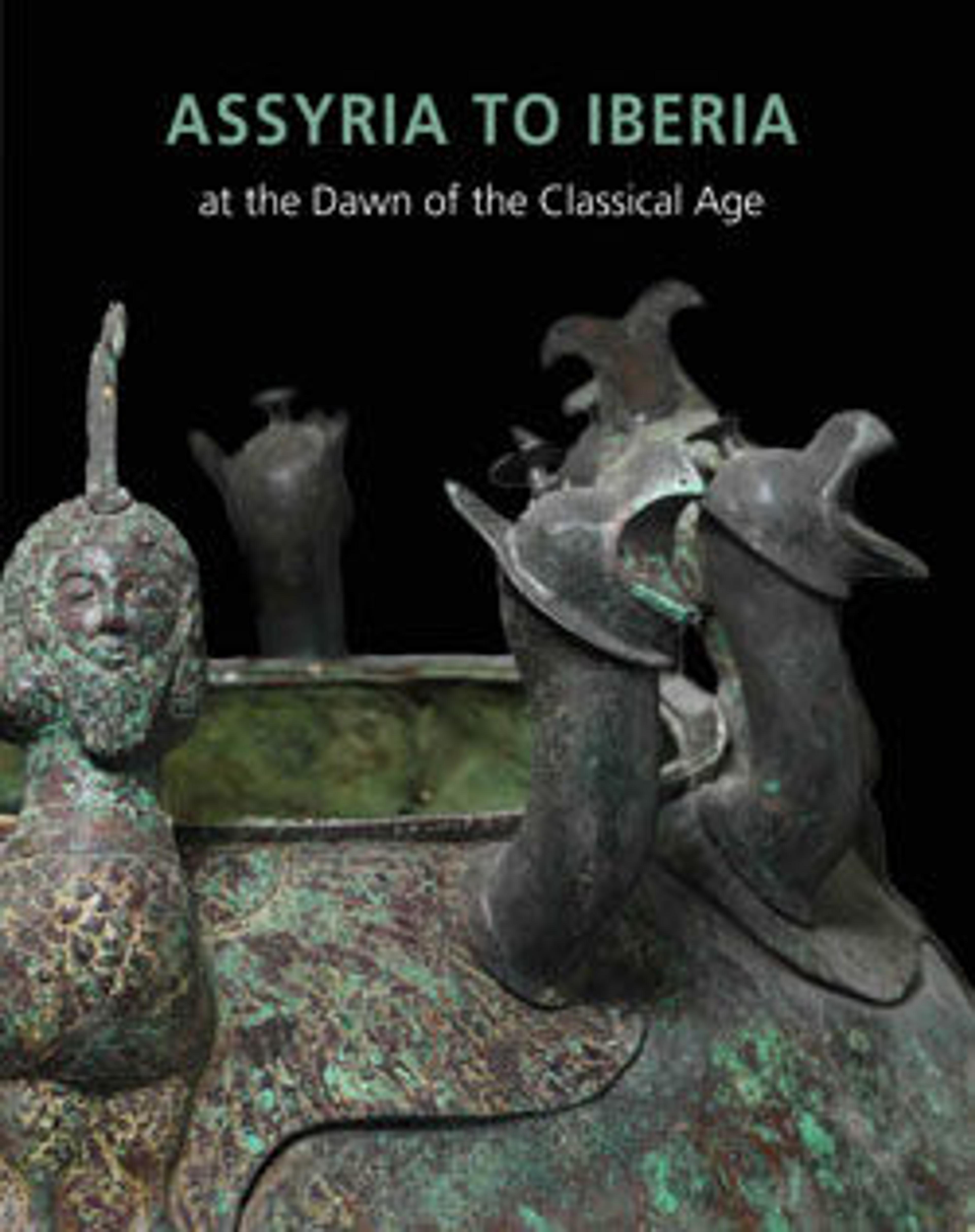Furniture plaque carved in relief with a male figure slaying a griffin
This plaque is carved in low relief with a male figure in profile wearing a pleated and fringed, knee-length, belted robe thrusting a long spear diagonally across his chest into the mouth of a griffin. The griffin, a hybrid creature with the head and wings of an eagle and the body and tail of a lion, fills the plaque, pressing its hind legs against the frame and thrusting its wings beyond the confines of the ivory in a dynamic composition characteristic of North Syrian ivories. Two fragmentary tenons, one preserved above the upper edge and one below the lower edge, suggest that this piece was originally set into a frame, likely as part of a piece of furniture. A hole drilled through the upper tenon probably aided in securing the plaque to a frame by means of a dowel. This piece displays Egyptian features frequently found on Phoenician ivories, including the pschent crown (the double crown of Upper and Lower Egypt) and the chevron-patterned apron that extends from the griffin’s chest. These features are combined with stylized elements drawn from North Syrian art, including the incised feathers of the griffin’s outstretched wings, the man’s robe, and his short, braided hair. Because this plaque draws on both Phoenician and North Syrian traditions of ivory carving, is has been classified as South Syrian, a style that occupies an intermediate position between the two.
Built by the Assyrian king Ashurnasirpal II, the palaces and storerooms of Nimrud housed thousands of pieces of carved ivory. Most of the ivories served as furniture inlays or small precious objects such as boxes. While some of them were carved in the same style as the large Assyrian reliefs lining the walls of the Northwest Palace, the majority of the ivories display images and styles related to the arts of North Syria and the Phoenician city-states. Phoenician style ivories are distinguished by their use of imagery related to Egyptian art, such as sphinxes and figures wearing pharaonic crowns, and the use of elaborate carving techniques such as openwork and colored glass inlay. North Syrian style ivories tend to depict stockier figures in more dynamic compositions, carved as solid plaques with fewer added decorative elements. However, some pieces do not fit easily into any of these three styles. Most of the ivories were probably collected by the Assyrian kings as tribute from vassal states, and as booty from conquered enemies, while some may have been manufactured in workshops at Nimrud. The ivory tusks that provided the raw material for these objects were almost certainly from African elephants, imported from lands south of Egypt, although elephants did inhabit several river valleys in Syria until they were hunted to extinction by the end of the eighth century B.C.
Built by the Assyrian king Ashurnasirpal II, the palaces and storerooms of Nimrud housed thousands of pieces of carved ivory. Most of the ivories served as furniture inlays or small precious objects such as boxes. While some of them were carved in the same style as the large Assyrian reliefs lining the walls of the Northwest Palace, the majority of the ivories display images and styles related to the arts of North Syria and the Phoenician city-states. Phoenician style ivories are distinguished by their use of imagery related to Egyptian art, such as sphinxes and figures wearing pharaonic crowns, and the use of elaborate carving techniques such as openwork and colored glass inlay. North Syrian style ivories tend to depict stockier figures in more dynamic compositions, carved as solid plaques with fewer added decorative elements. However, some pieces do not fit easily into any of these three styles. Most of the ivories were probably collected by the Assyrian kings as tribute from vassal states, and as booty from conquered enemies, while some may have been manufactured in workshops at Nimrud. The ivory tusks that provided the raw material for these objects were almost certainly from African elephants, imported from lands south of Egypt, although elephants did inhabit several river valleys in Syria until they were hunted to extinction by the end of the eighth century B.C.
Artwork Details
- Title:Furniture plaque carved in relief with a male figure slaying a griffin
- Period:Neo-Assyrian
- Date:ca. 9th–8th century BCE
- Geography:Mesopotamia, Nimrud (ancient Kalhu)
- Culture:Assyrian
- Medium:Ivory
- Dimensions:H. 4 1/8 x W. 4 11/16 x D. 7/16 in. (10.5 x 11.9 x 1.1 cm)
- Credit Line:Rogers Fund, 1961
- Object Number:61.197.11
- Curatorial Department: Ancient West Asian Art
More Artwork
Research Resources
The Met provides unparalleled resources for research and welcomes an international community of students and scholars. The Met's Open Access API is where creators and researchers can connect to the The Met collection. Open Access data and public domain images are available for unrestricted commercial and noncommercial use without permission or fee.
To request images under copyright and other restrictions, please use this Image Request form.
Feedback
We continue to research and examine historical and cultural context for objects in The Met collection. If you have comments or questions about this object record, please contact us using the form below. The Museum looks forward to receiving your comments.
